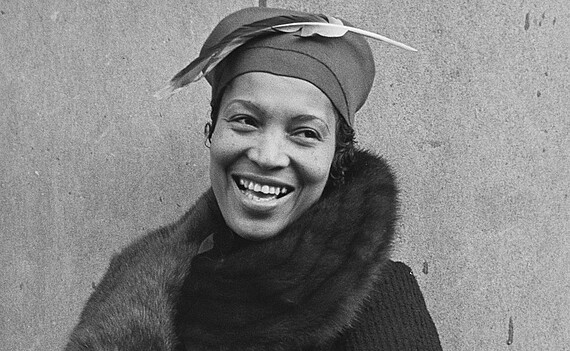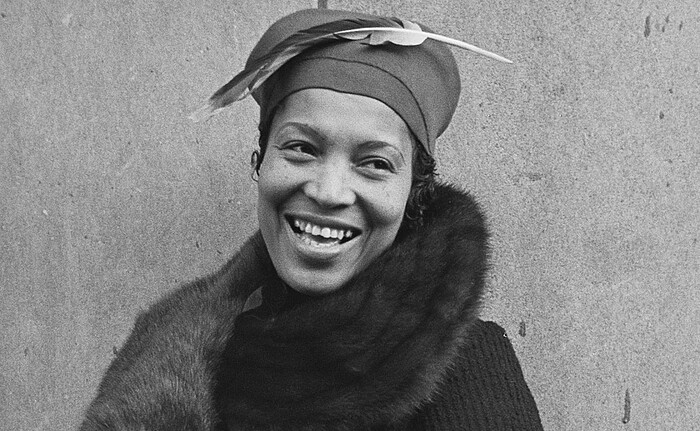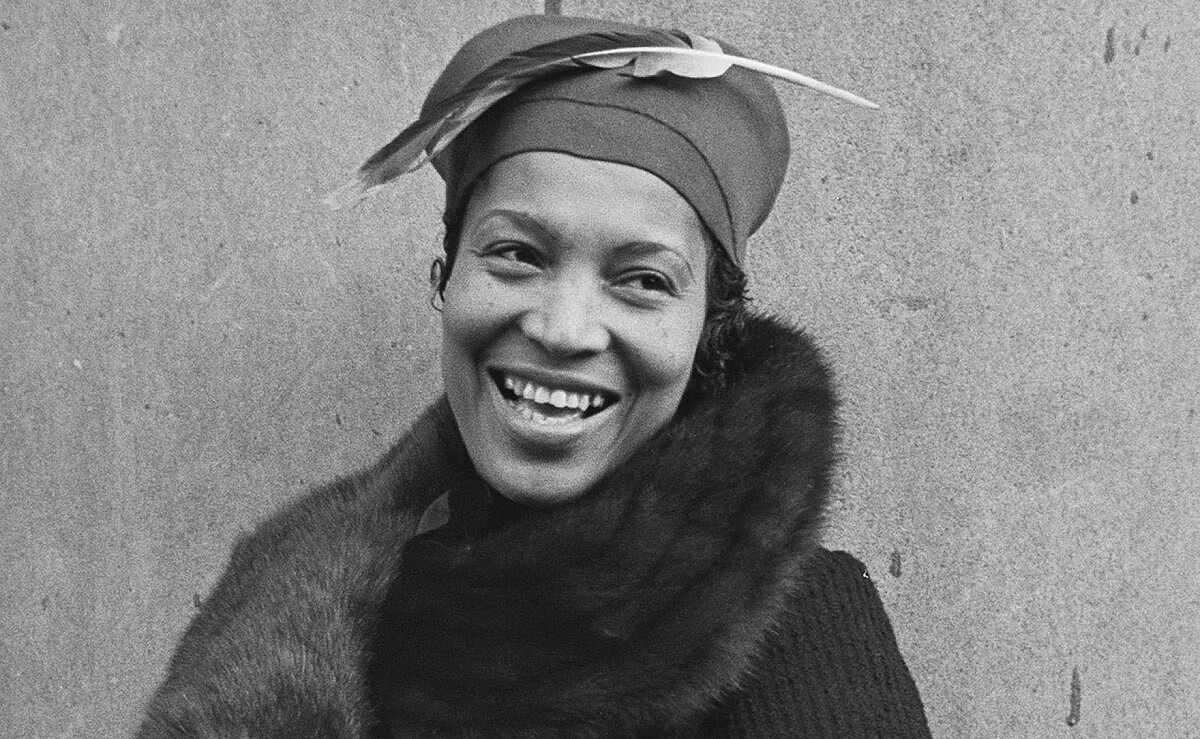

 ©
Zora Neale Hurston (1891-1960) portrait, ca. 1920, by Carl Van Vechten in Beinecke Rare Book & Manuscript Library and The Van Vechten Trust
©
Zora Neale Hurston (1891-1960) portrait, ca. 1920, by Carl Van Vechten in Beinecke Rare Book & Manuscript Library and The Van Vechten Trust
Zora Neale Hurston (1891–1960) was an African American writer, anthropologist, and folklorist. A central figure of the Harlem Renaissance, she conducted fieldwork in the US-American South and the Caribbean, including Haiti, where she studied folklore and voodoo practices. Her book "Tell My Horse“ (1938) documents her research on Afro-Caribbean traditions, while her acclaimed novel "Their Eyes Were Watching God“ (1937) explores themes of race, gender, and identity. Hurston's work bridged anthropology and literature, preserving and celebrating Black cultural heritage. In this episode, we concentrate on her work on the phenomenon of the "zombie“ in Haiti.
TRANSCRIPT
Sophie: Content note. This episode includes topics surrounding death, dead bodies and drugs. Please continue with care.
[Caribbean music]
Lilly: “No one can stay in Haiti long without hearing Zombies mentioned in one way or another, and the fear of this thing and all that it means seeps over the country like a ground current of cold air. This fear is real and deep.” (Tell My Horse 179)
Jonah: This is what Zora Neale Hurston had to say about Zombies in Haiti. She is however not talking about the Zombies we think of today when we hear that term. They have little in common with the flesh-eating, walking corpses we are used to seeing on television or in the cinema scaring us to death. No, Hurston speaks of a phenomenon that was quite prevalent and truly real in Haiti in the 1930s.
[Caribbean music]
Jonah: Welcome to another episode of the podcast “Black Heroines of the 20th century”. This episode focuses on one of the most important thinkers and versatile people of the 20th century, the author and anthropologist Zora Neale Hurston, and her work on zombies in Haiti. While a number of Hurston’s works are well known and discussed in universities and by other scholars, her autobiography Dust Tracks on the Road or her novel Their Eyes Were Watching God being only two examples one publication rarely mentioned in the academic community is Tell My Horse (Emery 327). In Tell My Horse, Hurston published the findings of her fieldwork studies in Jamaica and Haiti during the 1930s. Her work in Haiti focused on voodoo practices and on the phenomenon of Zombies. We want to talk about her research and work during this time and thus highlight a work that has been ignored, paid little attention to and called her “poorest book” (Hemenway 248 as quoted in Emery 327). To do this, we would first like to introduce Zora Neale Hurston as a writer and anthropologist, before looking at the specific case of Tell My Horse and the experiences she shared in the book. Finally, we want to look at what made her work so special and what influences she had on the anthropology community.
Jonah: Before diving into the specifics of her studies and findings presented in Tell My Horse, we want to give you some background information on Hurston herself and the time she spent in Haiti. Zora Neale Hurston was born on January the 7th, in 1891, Notasulka, Alabama as the daughter of John Hurston, a carpenter and Baptist preacher, and Lucy Potts a former schoolteacher. She grew up in Florida, a state in which slavery was still allowed until 1865 and in which the black population were still oppressed and discriminated against by racist laws and segregation. It would take another 80 years before Jim Crow laws and racial segregation were finally abolished (“About Zora Neale Hurston”).
It seems that Hurston had some connections to supernatural or spiritual elements already early in her life. In her autobiography Dust Tracks On The Road, Hurston tells us about visions she had when she was not older than seven. She claims to have experienced strange dreams in which she saw twelve scenes showing her own future. These dreams were no ordinary dreams, she knew that everything she saw was going to happen. From an early age she knew that she would end up orphaned, homeless, cold and friendless (Dust Tracks 56-57). In 1936 Hurston was rewarded with a Guggenheim fellowship, her declared field being "Literary science", her interest " a study of magic practises among [...] the West Indies" (King 275-276). For her personal life, this journey to the Caribbean was a kind of self-imposed exile because of love troubles with a former boyfriend (King 291). For her academic life, this year she was at the height of her power as a writer and an intellectual with two published books and working toward a doctorate (“About Zora Neale Hurston”). After a first stop in Kingston, Jamaica, in September, she took a ship to Port-au-Prince in September the same year, setting up a shop on the outskirts of the capital and starting to learn Creole (King 276-279).
Haiti plays a critical role in the African American imaginary, being the centre of African diasporic culture of Vodou (Fischer-Hornung 347). Hurston, among other scholars, attempted to get a better understanding of Vodou and Hoodoo in this culture. She arrived in Haiti two years after the US troops had left. America's presence had cut deeply into Haitian society, authorities had banned "vodou" and raided hounforts, drums were seized and destroyed. The U.S. saw its enemy as an otherworldly one: a set of religious ideas, rooted in a specific culture, which in turn justified the violence used to eradicate them. In 1929, William Seabrook published his book The Magic Island, that is famously known for introducing the word “zombie” to the Western world. William Seabrook described the nature of the “zombie phenomenon” more as a pharmacological than supernatural (King 282). Hurston later corroborated certain facts from his book, but her research was based on far more insights in the ceremonies, making her contribution essential.
[Caribbean music]
Jonah: Now, what has Zora Neale Hurston experienced during her time in Haiti? She explains that if you stay in Haiti for any length of time, you cannot help but hear about Zombies. The fear of these Zombies was everywhere in Haiti during the 1930s. Hurston reveals how the lower classes actually talk openly about these fears in their everyday conversations, while the upper classes do not – probably out of fear since it wouldn’t be appropriate for respectable members of society to talk about myths. Because that is what a number of upper-class members told Hurston about Zombies: that they were nothing but myths (Tell My Horse 179-181). And yet, Hurston claims to have seen a Zombie herself and to be the first person to ever photograph a Zombie.
Lilly: "But I had the good fortune to learn of several celebrated cases in the past and then in addition, I had the rare opportunity to see and touch an authentic case. I listened to the broken noises in its throat, and then, I did what no one else had ever done, I photographed it. If I had not experienced all of this in the strong sunlight of a hospital yard, I might have come away from Haiti interested but doubtful. But I saw this case of Felicia Felix-Mentor, which was vouched for by the highest authority. So I know that there are Zombies in Haiti. People have been called back from the dead." (Tell My Horse 182)
Jonah: But what actually is a Zombie? According to Hurston’s research, Zombies are essentially resurrected humans. They are created because of three reasons: they can be used as strong workers, they can be created out of an act of revenge, or they can be made as a sacrifice in some kind of ceremony. They are, however, unable to speak. What exactly is involved in making Zombie is unclear (Tell My Horse 189) but some of the people Hurston spoke to are of the opinion that true priests of Voodoo do not participate in these practices (Tell My Horse 189). They also told Hurston about possible precautions one can take to avoid their loved ones being turned into a Zombie: one example, families and friends can take a 36-hour watch at the grave, since apparently after that a body cannot be turned into a Zombie anymore. Other precautions include poisoning the body or cutting it open to ensure its real death (Tell My Horse 191). But let’s talk about some of the actual cases that Hurston documented in Tell My Horse. She recounts four different instances in which zombies have been sighted. All of these tell the tale of people who initially died but were seen again later, seemingly alive and well, but unable to speak or recognise their loved ones (Tell My Horse 192-194). Apart from these cases, which Hurston only learned about by the retellings of others, she also went to see one of these so-called Zombies herself. On November 8, in 1936, Hurston spoke with Dr. Rulx Léon, the Director-General of the Service d’Hygiene. He told Hurston about a Zombie that was said to be found on the road and taken to a hospital and he gave her permission to investigate the case further. This Zombie was Felicia Felix-Mentor, a woman who had suddenly taken ill and died in 1907. According to Hurston, there are documents that prove all this. Nearly 30 years later, in October ‘36, a sighting of a naked woman was reported. This same woman then appeared on a farm, claiming it was her father’s and she used to live there. Her brother and her husband were called on to confirm her identity, the latter only doing so reluctantly since he had achieved a good standing in society and did not want to have anything to do with Zombies. Arriving at the hospital, Hurston received help from the chief of staff there who explained that Felix-Mentor did not eat the food they had placed in front of her. As soon as the woman sensed them approaching, she broke off a branch of a nearby bush and began swiping the floor and the fence with it and covered her face with some cloth. Two doctors that had come with Hurston tried to calm the Women down and take the cloth off her face, but she just used her hands to shield her face instead. Hurston took a few pictures of this Zombie with her face covered (Tell My Horse 194-195). One of the doctors then forcibly uncovered her face and Hurston described what she saw in the following way.
Lilly: "Finally the doctor forcibly uncovered her and held her so that I could take her face. And the sight was dreadful. That blank face with the dead eyes. The eyelids were white all around the eyes as if they had been burned with acid. It was pronounced enough to come out in the picture. There was nothing that you could say to her or get from her except by looking at her, and the sight of this wreckage was too much to endure for long." (Tell My Horse 195)
Jonah: Hurston talked to the doctors about the Zombie phenomenon afterwards. They concluded that some kind of drug has to play a role in this, a drug that evoked a state similar to death and that destroyed parts of the brain that are responsible for speech and will power. It had to be some kind of drug that was unknown to most, probably brought from Africa and that was handed down from generation to generation. Hurston was determined to do some further research on this drug, but the doctors warned her. They were also intrigued and wanted to know more about this drug and its antidote but were scared of the societies these drugs were known and used in. They were scared for their lives, should they try to investigate further. But that did not seem to stop Hurston. She was still determined to try (Tell My Horse 196).
[Caribbean music]
Jonah: Why is Zora Neale Hurston’s way of researching and writing about anthropology seen as so special and different from any other anthropologist? The answer to this can probably be found when looking at the two professions Hurston can be sorted into: First, she was an anthropologist as well as an author. When reading any of her works – from her novels like Their Eyes Were Watching God to her autobiography Dust Tracks On The Road and the aforementioned Tell My Horse – one can easily tell that she really combined anthropology with the art of writing as an author. Frank A. Salamone describes her way of writing in the following way:
Selma: "Hurston fostered an anthropology which embraced every aspect of human life. She also knew that poetic or literary truth revealed a good deal about human culture and ways of behavior. Therefore, she did not clearly delineate between one form of capturing human culture and another." (218)
Jonah: The case of the so-called Zombie Felicia Felix-Mentor that we just discussed is also a great example to why Zora Neale Hurston’s way of researching and writing is seen as so different from most anthropologists. Hurston decided that she wanted to try to find out how exactly Felix-Mentor ended up in this condition, how she ended up becoming a Zombie. Hurston believed that the key to understanding the Zombie phenomenon was to actually believe in them. She did see the Zombie culture as a form of faith and as a form of social power – and therefore as a way in which people made sense in the world today. She furthermore believed that looking at the gods in the voodoo culture could help us to understand how people see themselves and their own lives since, to quote Hurston “Gods always behave like the people who make them.” (Tell My Horse 219). Salamone further describes her anthropologic work as follows:
Selma: “She anticipated a more reflexive and subjective anthropology in which the narrator was no longer privileged, and the subject allowed to speak for her or himself." (217)
Jonah: That was our short episode on Zora Neale Hurston's work in Haiti. Thank you for listening. We would like to end by giving a voice to the artist herself. There is a short video of her, probably made during her time in Florida, called "Zora Neale Hurston Sings and Performs the Crow Dance". The Crow Dance is one of the African-American folk dances that originated in the early 19th century and is a blend of Native American and European culture. Like many of these folk dances, the Crow Dance originated in the context of slavery. It was a form of resistance and resilience and played a role in preserving and expressing African heritage and culture. It is a statement to the creativity and resilience of African Americans even in the face of oppression. Although this recording was made in a context unrelated to Hurston's research on Zombies, it may give a little more insight into the kind of anthropologist Zora Neale Hurston was: always combining art and anthropology, research and fiction.
[Audio recording of Zora Neale Hurston performing the Crow Dance]
REFERENCES
Literature:
- Emery, Amy Fass. “The Zombie In/As the Text: Zora Neale Hurston's "Tell My Horse."” African American Review, vol. 39, no. 3, 2005, pp. 327–336.
- Fischer-Hornung, Dorothea. ““Keep Alive the Powers of Africa”: Katherine Dunham, Zora Neale Hurston, Maya Deren, and the Circum-Caribbean Culture of Vodoun.” Atlantic Studies, vol. 5, no. 3, 2008, pp. 347–362.
- Hurston, Zora Neale. “Hoodoo in America.” The Journal of American Folklore, vol. 44, no. 174, 1931, pp. 317–417.
- Hurston, Zora Neale. Dust Tracks on a Road. An Autobiography. J.B. Lippincott Company, 1971 [1942].
- Hurston, Zora Neale. Tell My Horse: Voodoo and Life in Haiti and Jamaica. Harper-Collins, 2000.
- King, Charles. The Reinvention of Humanity. Penguin, 2019.
Sources:
- The Official Website of Zora Neale Hurston.
https://www.zoranealehurston.com/about
Sounds:
- “Zora Neale Hurston Sings and Performs the Crow Dance.” YouTube, uploaded by Andrew Rasmussen, 12.08.2013. https://www.youtube.com/watch?v=3g9WyHsMj4Q.
- “Cuban Sandwich” by Kevin MacLeod (incompetech.com). Licensed under Creative Commons: By Attribution 3.0. http://creativecommons.org/licenses/by/3.0/
- Additional sounds created with Suno.

